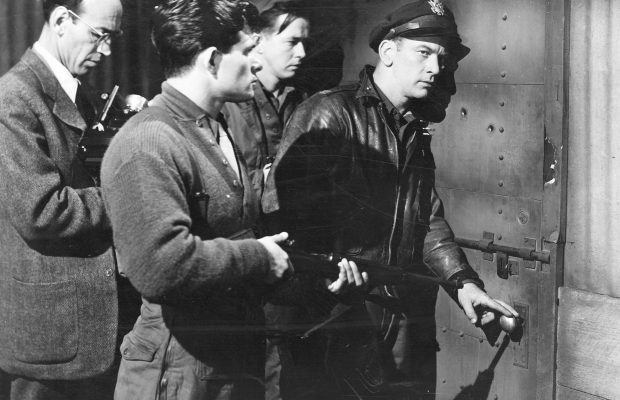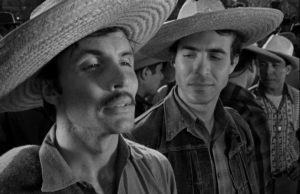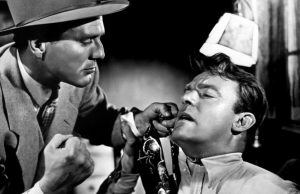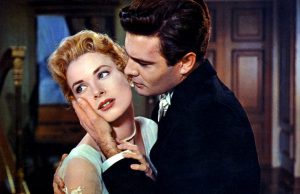The Thing from Another World (1951)

 |
Run Time: 87 min. | b/w
Director: Christian Nyby Stars: Margaret Sheridan, Kenneth Tobey, James Arness Genres: Horror | Sci-fi |
| Storyline A scientific research station in the Arctic finds “something” preserved in the ice. A terrifying thriller about a hostile visitor who regards human beings not as brothers, but as sustenance. A B-movie, but this skillfully directed chiller remains one of the great sci-fi films. |
|










While I love the remake very much I was finally able to see the original all the way thru without the colorization on TV. It is a truly awesome movie.
Comparing the two is not really fare or easy as Carpenter’s version has the benefits of modern movie magic. But that is in my opinion the only place it excels. It seems in the remake all the characters are derelicts and for the most part not very likeable. In the original you had a sense of these people liking each other and sticking together.
Kenneth Tobey is a very good and believable leader of his men. He also shows a very human side in that he realizes he is not the smartest of men. He is what he is. A captain of a small band of Air Force Soldiiers simply doing their job.
Robert Cornblaithe is excellent as Dr. Carrington. He comes of snootish yet still likeable enough because you can see that deep down he really admires Captain Hendry (Tobey) though he can’t see eye to eye with him on their situation or dealing of his "Thing From Another world."
Every character in the movie is well played. They all look like they belong in their roles. Their look and attire fit their characters and when one guy is called Professor so and so or whomever, you believe it unlike many movies in those days where they picked anyone to play the supporting actors. There is one thing though, Margaret Sheridan’s pants pulled up almost to her neck line (exaggeration…but close) I could have done without. I realize it was a style of the times but I think they could have given her something a little better to show off her figure when you first meet her. Especially since she was the only female love interest and was tagged as "a pinup girl" in earlier scenes. She looks better when her hair is down and she is in different clothes. I know that is being picky but I just had to say it.
The creature is better presented in the original as far as being frightening. You hardly ever see him. When you do it’s only for brief periods at a time and usually in the dark. That frightening sound of "The Thing" is very original in that it’s not just a growl but sounds like a cat meowing at times. Very eerie!
The story is well known and both are similiar although I must admit the remake is closer to the actual Campbell JR.’s short tale. But the original still gives it a good account and in many ways surpasses the short story because it is easier to identify with the creature since he’s humanoid.
It boils down to suspense, drama and mood versus gore, F/X, and fast paced action. Both movies are top notch. I am proud to own both and would not try and say one is overtly better than the other. The remake has the benefits of the then modern movie technology. The original had the benefit of black and white to add to the suspense and utter danger they are in. The choice is yours. I myself enjoy the original a little more as it holds up today probably better than any other Sci-Fi movie from that era.
"The Thing" without a doubt is one of the finest science fiction films ever made. A group of scientists and air force officers at an Arctic station discover something in the ice and that something sees them as dinner. The battle goes on in the claustrophobic station in a scenario that without a doubt was the model for the original "Aliens". The cast is a very fine ensemble and the direction is crisp and on the edge. Conversations overlap and at times runs simultaneously but the direction is so good that you miss nothing. Best of all is that this is one of those films where what you don’t see is what scares you. There is no splatter or graphic detail but tantalizing hints that lets your mind conjure up your worst nightmare. A great one for a dark and stormy night.
Let me get my two (minor) complaints out of the way first: the attempt to get the UFO out of the ice felt rushed (as in the filmmakers wanted to get to the rest of the film) because I saw the result coming a mile away . . . it just felt soulless and obligatory. Second, the scientist Dr Carrington, rubbed up with the ‘mad scientist in pursuit of knowledge risking everyone’s life’ cliché a bit too much for me . . . and I was trying to be forgiving since this was 50 years ago and far less cliché then.
All right, now . . . I have to say, I loved The Thing from Another World. I loved the dialogue in this movie. It’s been a long long (Jesus Christ, a loooong) time since I had this much fun listening to exposition. Yes, exposition. The obligatory plot details that no one cares about that some poor sap spells out? Yes, that exposition! Thing from Another World actually gains momentum with its exposition whereas your typical film slows down and comes to a screeching halt for it.
Nyby spreads the exposition across about half a dozen characters, and they have real conversation with overlapping, quick fire, back and forth, dialogue, and in brief instances multiple conversations going at the same time. The result? Five minutes of exposition becomes one minute of exposition. Will the audience catch every single detail of their plan? No, but the audience doesn’t need to either. Thank you Howard Hawks!
Lace this exposition with characterization, inside jokes amongst characters, hints at their history together, and friendly pranks, and The Thing from Another World not only knocks out exposition with one blow, but develops their characters simultaneously, yielding a wonderfully complex and realistic relationship between the characters and plot. No spot light and overdone Shakespearian aside with melodramatic boo-hoo backstory that brings elicits yawns and groans, no little nerd with all the answers getting to explain everything while everyone asks stupid questions–nope–the Thing from Another World is above that drivel.
Nyby and Hawks sold me on the characters from the get go, placing emphasis on how they introduce the characters and not so much in what their character backstory is. I salute the filmmakers for this decision, and in response was more than willing to suspend my disbelief for the sake of the film’s needs.
Follow it up with well lit and well staged action sequences–the fire scene was perhaps one of the most beautiful and glorious moments caught by b/w photography–and the Thing from Another World delivers with all its 1950s charms. I’ll take a film with narrow corridors and electrodes over all out war with CGI bugs/machines any day of the week.
Which version, Hawks or Carpenter? There's a lot of talk about which one is better, etc. I do agree with many that they both are very different films, very different viewing experiences. I love most good sci-fi. Some of 50's sci-fi can be dated after viewing. I do not think The Thing is one of these films which suffers from time . It holds up splendidly. If you like dialogue, you'll love this movie. If you like innuendo, fast paced overlapped dialogue, great characters – and I don't use that word lightly – you'll love this movie.
If you want more suspense, a lot more blood, and a much more gloomy setting, certainly John Carpenter's remake is better in these areas. I own and enjoy viewing both films.
Certainly, the creature in Carpenter's version is much more frightening, and truer to the John Campbell short story from which the story is based. His shape shifting would have been impossible to show in the 50's version with the believability that is possible in today's F/X field.
Carpenter gives us a setting which is darker, colder, and more foreboding. A feeling of hopeless, and nameless dread pervades the camp. Certainly, the notion is clear that this could be the end of all of them, and of the world. There's both a lot less thinking, and a lot more action to be had here in the Carpenter 80's version than in the Hawks' 50's approach.
Hawks, by contrast, created a feeling of "whistling in the dark", which dominates the setting. The characters, and they are many and varied, all have their own particular take on what is happening and what should be done about it. There is a sense of hopeful, "We can do it. We can solve this problem" attitude throughout the entire film. This feeling of "let's keep our heads" is contagious and very quickly the audience finds itself rooting, rather than running.
One more point, and I think it's a big one. The characters in the Howard Hawks' 50's film are all likable, including the "heavy" – the wonderful Dr. Carrington. All the characters are capable, and in many cases, quite resourceful and ingenious. Each, always maintains a humorous, dry wit angle of attack on the situation without resorting to camp or parody seen in most comic film writing today. The military crew members, very quickly in the story, each displays a comical personality ribbing both the captain and the civil service nature of the military with natural ease. As someone once said, a complaining soldier is a happy soldier. So true. This is certainly no "military has all the answers" flick. The mistakes they make are roundly criticized by all in attendance, including the co-pilot's not so subtle comment about the splitting of the atom, "yeah, and that sure made the world happy, didn't it?" (laughter). Add to that, Ned Scott the newspaper man, and you've got a non-scientist, non-military chronicler character to round out the story, and give the audience someone with comparable skepticism about what to do next. Ned is the outsider who is now, like us, on the inside.
The John Carpenter version, by comparison, has mostly losers populating the story, I have to say. From the camp leader, Gary, on down to the radio operator, Windows, most of the characters seem more suited as inmates in a minimum security prison than manning a research science station. (maybe a reflection of the lack of students going into the field of science in recent years? (chuckle) And to make the point even more ironic, there is no military, the usual scapegoats, in the Carpenter version. (Gary, as leader, carries the gun, and we assume has some military/policing role, though it is never made clear in the film.) These are all scientists with the exception of the helicopter pilot, played by Kurt Russell, who seems to be the only clear thinking member of the entire bunch. Why none of the actual scientists approach the problem as clearly, and logically as the rogue washed-up helicopter pilot is also a mystery and in large part, a flaw.
In Hawks' version, Captain Hendry solicits advice from all in attendance, frequently asking the scientists and his crew technical questions for which he has no background to answer. This also gives the non technical audience member another "way in" to the technical side of things. (no pun intended)
Why Carpenter chose to have most of the characters unredeeming, lazy, and in most cases, quite stupid and ill behaving, is a mystery. I find the characters in the Hawks version much more true to life.
With all that said, I enjoy both films, each for their strengths and for their weaknesses. If you want blood and gore, more realistic sets, and are not discouraged by fairly shallow characters, the Carpenter version is for you.
If you want fast paced dialogue, memorable characters, and you enjoy a "can-do" attitude in dreadful circumstances, all done with a minimum of visible gore, then Hawks' The Thing awaits you.
humbleservant